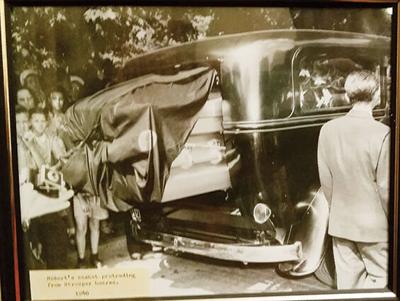EDITOR'S NOTE: Special thanks to Pam Bierman at Hayner Public Library: Genealogy & Local History Library, Brian Combs at Alton Museum of History and Art Inc. and Justin Parmley at Franklin Masonic Lodge for their assistance developing this spotlight.
An otherwise healthy young boy and man, Robert had problems throughout his life with his feet, having little sensation in them and often not sensing problems such as chafing until blisters formed. While making an appearance in late June 1940 in Manistee, Mich., with Kirsh and accompanied as usual by his father, Harold Sr., Robert became ill. Kirsh said the brace Robert wore in his left shoe to support his ankle had chafed, and a blister formed that would become infected.
On July 4, 1940, doctors confined Robert to a hotel bed. After emergency surgery and blood transfusions to alleviate the problem, the infection lingered and Robert’s fever continued to rise. On July 15, at 1:30 a.m., Robert died in his sleep in the room at Chippewa Hotel. He was 8 feet, 11.1 inches tall and 490 pounds when he died, according to Alton museum records. Other historical records indicate he was 439 pounds when he died.
Robert’s body was brought back home to Alton to his final resting place. His 1,000-pound casket took 12 pallbearers, all Masons, to move — with the help of 8 other men from the funeral home. A 10-foot floral blanket made of 300 white lilies covered Robert’s casket, which was a 10-foot, 6-inch steel casket, 32 inches wide and 30 inches high.
Streeper Funeral Home, now Elias, Kallal and Schaaf Funeral Home on Edwards Street in Alton, handled the arrangements. It’s estimated more than 40,000 people made their way past the funeral home to pay their final respects, and more than 10,000 attended services on July 19, 1940. All city businesses were closed for Robert’s funeral.
The pipe organ at Main Street United Methodist Church, of which Robert had spearheaded the fundraising campaign for, played music over a public address system for the funeral home more than a block away.
Burial rites were given by both the Order of the DeMolay and the Franklin Masonic Lodge. DeMolay members also provided an honor guard for Robert’s funeral services, standing by his casket throughout — at the funeral home, alongside the hearse as it traveled to the cemetery, and until his remains were securely sealed in the 12-foot-long reinforced concrete tomb comprising two normal-size gravesites.
Robert’s final resting spot was chosen to be in Oakwood Cemetery, now Upper Alton Cemetery. When his casket was lowered into the reinforced concrete vault, it was placed inside a red cedar box. A concrete mixer was rolled up to seal the coffin with concrete and further reinforced with steel. The family, fervently protecting Robert from post-mortem studies, did not have an autopsy performed and Robert’s body was laid to rest fully intact.
The family took extra measures to secure his gravesite from predators and prevent marketing of “freak memorabilia.” They burned most of Robert’s belongings immediately after his death. Finally “At Rest,” as inscribed on his headstone, Robert has since been joined at Upper Alton Cemetery by both of his parents, his two brothers and his two sisters.







